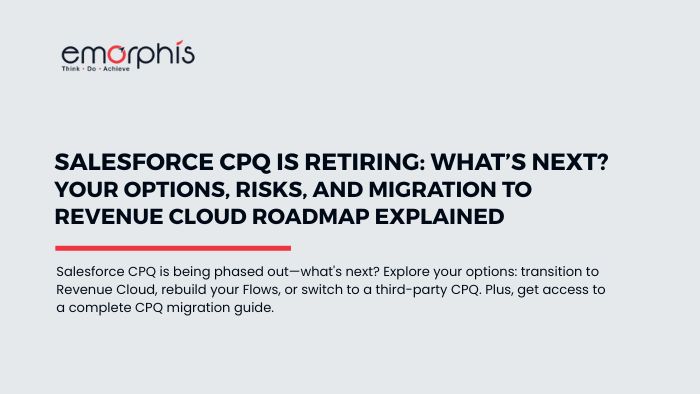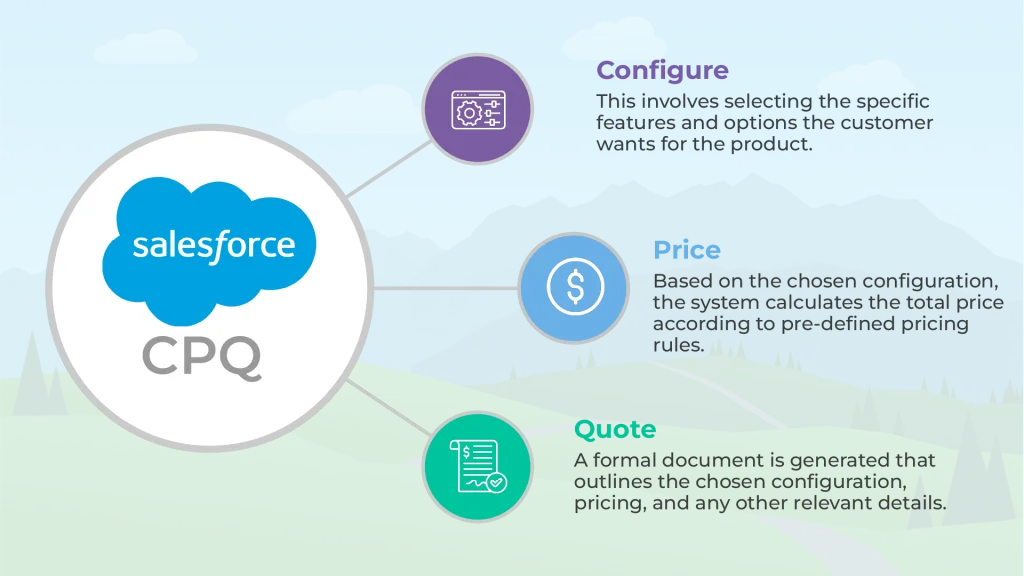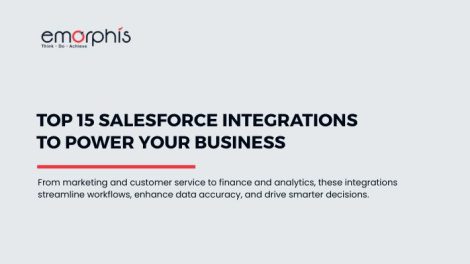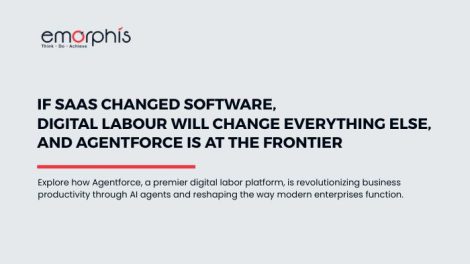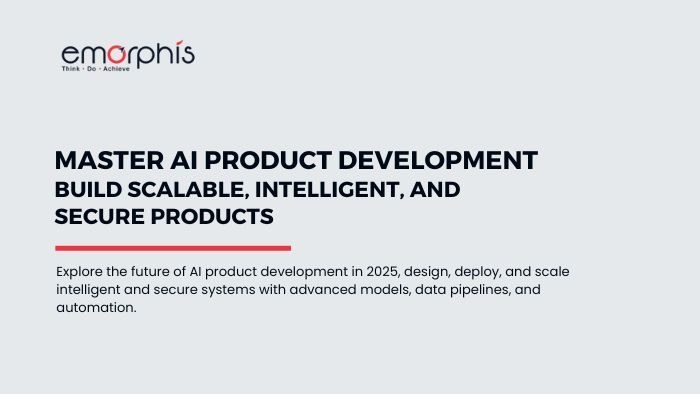If you're currently using Salesforce CPQ (formerly SteelBrick), you're likely facing a pivotal decision. Salesforce has officially ended new sales of its CPQ solution. While existing customers will continue to receive limited support, there are no new features, updates, or AI advancements on the horizon.
This announcement has left many businesses uncertain about their next steps.
Do you stay with your existing setup and risk stagnation? Do you move to Revenue Cloud, rebuild your CPQ capabilities with custom tools, or explore third-party alternatives? And how do you manage your existing customizations, integrations, and data models that are already tightly woven into Salesforce?
If you’re feeling the pressure to act, but don’t want to rush into the wrong decision, this article is for you.
What’s Happening: Understanding the Salesforce CPQ End-of-Sale Announcement
Salesforce CPQ has officially entered its end-of-sale phase. This means Salesforce is no longer offering the CPQ product to new customers. While current users can continue renewing licenses and receiving basic support, some important caveats make this more than a routine product update:
- No New Features or Enhancements
Salesforce has officially halted major development on CPQ—no new features, performance upgrades, or integration with its expanding AI ecosystem. This leaves teams with a solution that’s no longer evolving. - Slowed Support and Limited Roadmap
While existing customers will continue to receive basic support and bug fixes, updates have already slowed. Innovation on the CPQ product has been minimal and will continue to decline. - Focus Shifts to Revenue Cloud
Salesforce is now investing fully in Revenue Cloud—its next-gen quote-to-cash solution that combines CPQ, billing, and contract management, with automation and AI-readiness at its core.
For businesses still relying on Salesforce CPQ, this is a clear signal: Now is the time to plan your next move.
Why This Is a Turning Point for Your Business
Salesforce CPQ may still be functional, but keeping your business tied to a solution that’s no longer evolving is a risk, both operationally and strategically.
Here’s why this moment demands your attention:
- You’ve Likely Invested Heavily in Customizations
Many businesses have deeply customized Salesforce CPQ to support pricing models, approval flows, product bundles, and integrations. These setups are valuable but become liabilities during migration if not properly managed. Staying on a legacy platform adds to technical debt. - Your Quote-to-Cash Process May Already Be Under Pressure
Buyers now expect real-time pricing and automation. A static CPQ tool puts you behind, especially as competitors adopt Revenue Cloud and integrated CPQ+Billing solutions. - Your Integrations Could Start to Break
Salesforce CPQ often connects to ERP, billing, and eSignature tools. As those systems evolve, outdated CPQ features may cause disruptions. - You’ll Miss Out on New Capabilities
Revenue Cloud is where innovation is happening - AI, guided selling, contract automation. Legacy CPQ users risk falling behind.
In short, this isn’t just a product update; it’s a signal to evaluate your entire quote-to-cash ecosystem and future-proof your revenue operations.
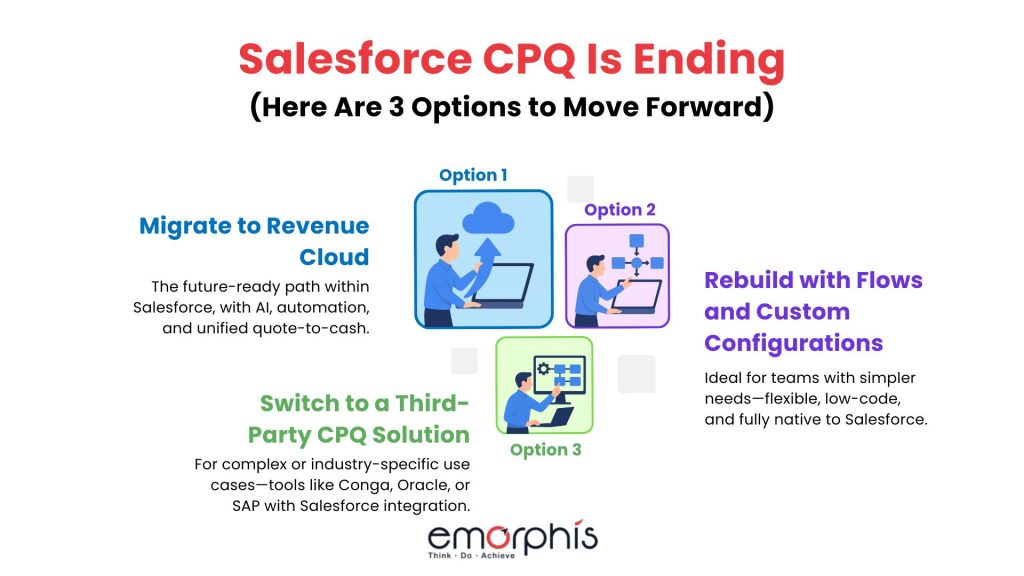
Option 1: Migrate to Salesforce Revenue Cloud
For businesses already invested in the Salesforce ecosystem, Revenue Cloud is the natural evolution of Salesforce CPQ. It’s more than just a replacement; it’s a unified quote-to-cash platform that connects quoting, billing, contract lifecycle management, and partner sales, all within a single, scalable environment.
Designed for Scale and Speed
Revenue Cloud is built to handle complex B2B and B2C scenarios, supporting everything from large product catalogs and high-volume transactions to subscription and consumption-based models. It’s modular, meaning you can start with CPQ and add billing or partner selling features as your needs grow—without rebuilding from scratch.
Seamless Integration with the Salesforce Ecosystem
Being part of Salesforce Customer 360, Revenue Cloud works natively with Sales Cloud, Service Cloud, and Commerce Cloud. This removes the need for third-party integrations or disconnected workflows, offering a fully unified revenue operations experience.
If you’ve been relying on workarounds or external apps in your current CPQ setup, this shift can streamline your architecture significantly.
Future-Ready with AI and Automation
Revenue Cloud is actively evolving with built-in AI capabilities—deal scoring, smart recommendations, pricing optimization—and serves as the foundation for Salesforce's investment in Agentforce and Einstein AI.
Built-In Tools for a Structured Migration
Salesforce provides tools for assessing readiness and migrating safely: compatibility checks, data model mapping, and logic translation. Still, migration can be complex, especially for highly customized orgs.
That’s where Emorphis comes in. Our Salesforce CPQ consulting services help assess your setup, minimize disruption, and build a phased roadmap for success.
When is this the right option?
- You’re staying in the Salesforce ecosystem
- You want long-term flexibility and innovation
- Need scalable billing and CLM
- You want to consolidate fragmented systems
Option 2: Rebuild CPQ Capabilities with Flow + Custom Salesforce Configurations
If your team only uses a subset of CPQ features—or you're working with relatively straightforward products and pricing—you might consider rebuilding your quoting logic using Salesforce-native tools like Flow, Approval Processes, and Custom Objects.
This “DIY CPQ” approach gives you more control and eliminates dependency on the retiring product—but it comes with trade-offs.
What You Can Rebuild Without Full CPQ
- Product configuration logic using Dynamic Forms and Flow
- Pricing rules using formula fields, pricing engines, or Flow logic
- Quote approvals using native Approval Processes
- Quote documents with Conga Composer or Salesforce Files
- Deal automation using Record-Triggered Flows
With Salesforce’s low-code capabilities growing stronger each year, this is a realistic path for teams with leaner quoting needs.
Pros
- Lower licensing costs (no separate CPQ licenses required)
- Complete flexibility over logic and UI
- Stays fully inside the Salesforce core platform
- Easier to test, iterate, and scale specific processes gradually
Cons
- Rebuilding advanced CPQ logic can get complex fast
(e.g., nested bundles, multi-tier discounts, usage-based pricing) - No centralized CPQ engine or product catalog
- Lack of native document generation and approval flows at CPQ scale
- Ongoing maintenance burden falls on your internal or partner team
This option may make sense if:
- You have light CPQ requirements
- Your sales team is small or mid-sized
- You want full control over the process
- You’re technically capable or have a Salesforce partner
But remember, what you save in licensing, you may spend in development time, testing, and support. This path is best taken when your quoting process is well-understood, repeatable, and relatively simple.
Option 3: Explore Third-Party CPQ Solutions
Salesforce CPQ isn’t the only CPQ tool on the market—and for some businesses, switching to a third-party CPQ solution might offer better fit, flexibility, or long-term value.
Several mature platforms have deep Salesforce integrations and offer features that rival or even surpass Salesforce CPQ, depending on your industry and needs.
Check out this blog and explore other CPQ solutions that can integrate with Salesforce.
The CPQ Migration Roadmap: Step-by-Step Decision Framework
Here’s a clear, step-by-step framework to guide your decision and migration strategy:
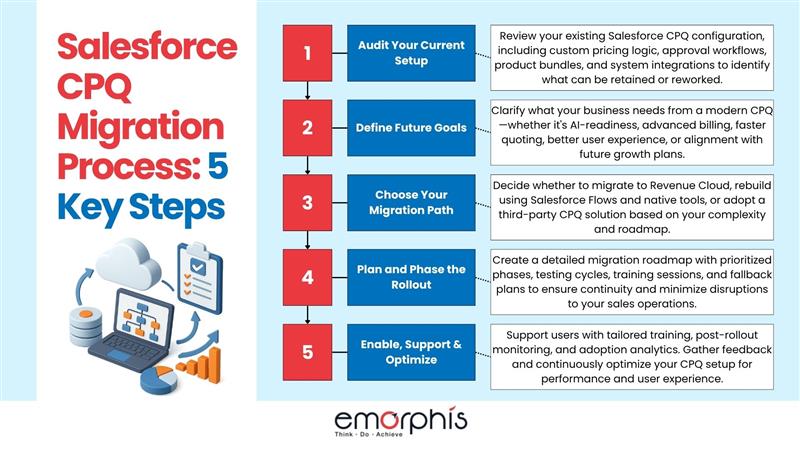
Step 1: Audit Your Current CPQ Setup
- Inventory all custom pricing rules, product bundles, approval workflows, templates, and integrations
- Identify what’s standard vs. highly customized
- List dependencies: Billing, ERP, eSignature tools, contract systems
Ask: What must stay the same, and what can be simplified?
Step 2: Evaluate Future Business Needs
- Are you scaling product lines or regions?
- Do you plan to introduce subscriptions, usage-based pricing, or partner quoting?
- How important are AI, automation, or multi-channel selling in your roadmap?
Ask: Is your current CPQ setup future-ready, or holding you back?
Step 3: Explore the Fit of Each Option
Use your audit and future goals to assess:
| Option | Best Fit For |
| Revenue Cloud | Existing Salesforce users, long-term scalability, AI/automation |
| Rebuild with Flow | Light CPQ needs, full control, internal dev resources |
| Third-Party CPQ | Specialized industries, broader stack transformation |
Step 4: Define Your Migration Path
- Choose whether to lift and shift or re-engineer
- Prioritize features into phases (e.g., pricing logic → approvals, → docs)
- Build a test plan and timeline for sandbox piloting
Tip: Don’t underestimate how much needs to be redefined, especially logic written years ago.
Step 5: Prepare for Change Management
- Align stakeholders (sales ops, finance, IT, end-users)
- Communicate what’s changing and why
- Design a training and support plan
- Plan for feedback loops post-rollout
Change management is not optional—it’s the difference between tool adoption and tool avoidance.
This roadmap not only gives you clarity—it helps ensure that whatever path you choose, the transition is strategic, structured, and successful.
What to Expect During CPQ Migration: Key Challenges to Plan For
Let’s look at the most common obstacles Salesforce CPQ users face during migration:
1. Custom Logic Doesn’t Map 1:1
Your existing Salesforce CPQ setup likely includes:
- Custom product rules
- Conditional pricing logic
- Multi-level bundles and approvals
- Workflow extensions
Translating this logic into Revenue Cloud or another system won’t be a copy-paste job. You’ll need to evaluate what to replicate, simplify, or re-engineer entirely.
2. Data Migration Is More Complex Than It Seems
Migrating quoting and pricing data involves:
- Field mapping
- Unit conversions
- Reference objects (like products, pricing tiers, discounts)
- Legacy data clean-up
Even minor mismatches can break quote accuracy or delay deals—so testing and validation are critical.
Explore related article – Guide to Salesforce Data Migration
3. Integration Dependencies Can Break
Your CPQ system is likely connected to:
- ERPs
- Billing platforms
- eSignature solutions
- Partner portals
- Custom APIs
Any of these integrations could fail or require rework during the transition. Having an Salesforce integration consultant on board is essential to avoid workflow disruption.
4. Knowledge Gaps: Slow Adoption
- Sales reps may resist the new quoting interface
- Ops and IT teams need retraining on admin and configuration tasks
- Misunderstandings can delay rollouts or reduce confidence in the system
Training, documentation, and feedback loops must be part of the rollout strategy, not an afterthought.
5. Underestimating the Time and Resources Needed
Migration often reveals messy or undocumented setups that take longer to clean up than expected. If you assume the transition will be fast or simple, you’ll risk:
- Missed deadlines
- Budget overruns
- Decline in sales team productivity
The smarter approach is to plan conservatively and phase the rollout with strong executive sponsorship and partner support.
These challenges aren’t roadblocks, but they do require a proactive, guided approach to solve efficiently. That’s where Salesforce CPQ consulting can make all the difference.
How Emorphis Can Help as Your CPQ Implementation Partner
Whether you’re migrating to Revenue Cloud, rebuilding quoting logic, or considering an entirely new CPQ solution, success hinges on more than just selecting the right tool—it’s about execution. That’s where Emorphis comes in. We start with:
CPQ Migration Audits
- Identify what can be retained or optimized
- Surface risks in pricing logic, integrations, or customizations
- Recommend the most suitable migration approach
Revenue Cloud Readiness Assessments
Thinking of migrating to Revenue Cloud?
We assess your:
- Product catalog complexity
- Pricing model scalability
- Integration and billing needs
- AI-readiness for future use cases
Customization and Integration Support
You’ll benefit from:
- Robust, scalable integrations
- Custom logic rebuilds (where needed)
- Workflow continuity across departments
End-to-End Project Execution
We don’t stop at migration. Our team supports:
- User enablement & training
- Change management strategies
- Post-deployment optimization
- Long-term CPQ and Revenue Cloud scalability planning

The Sooner You Plan, the Smoother the Shift
Salesforce CPQ may still work today—but with no updates, no AI roadmap, and limited support ahead, it’s clear that continuing as-is is a short-term play with long-term risk.
Whether you're leaning toward Revenue Cloud, considering a third-party CPQ platform, or exploring how to rebuild using Salesforce-native tools, now is the time to act, not react.
Emorphis is here to guide you through the complexities—migration audits, integration support, customization, and everything in between.
Let’s talk and gain clarity on the best-fit path forward for your team.



